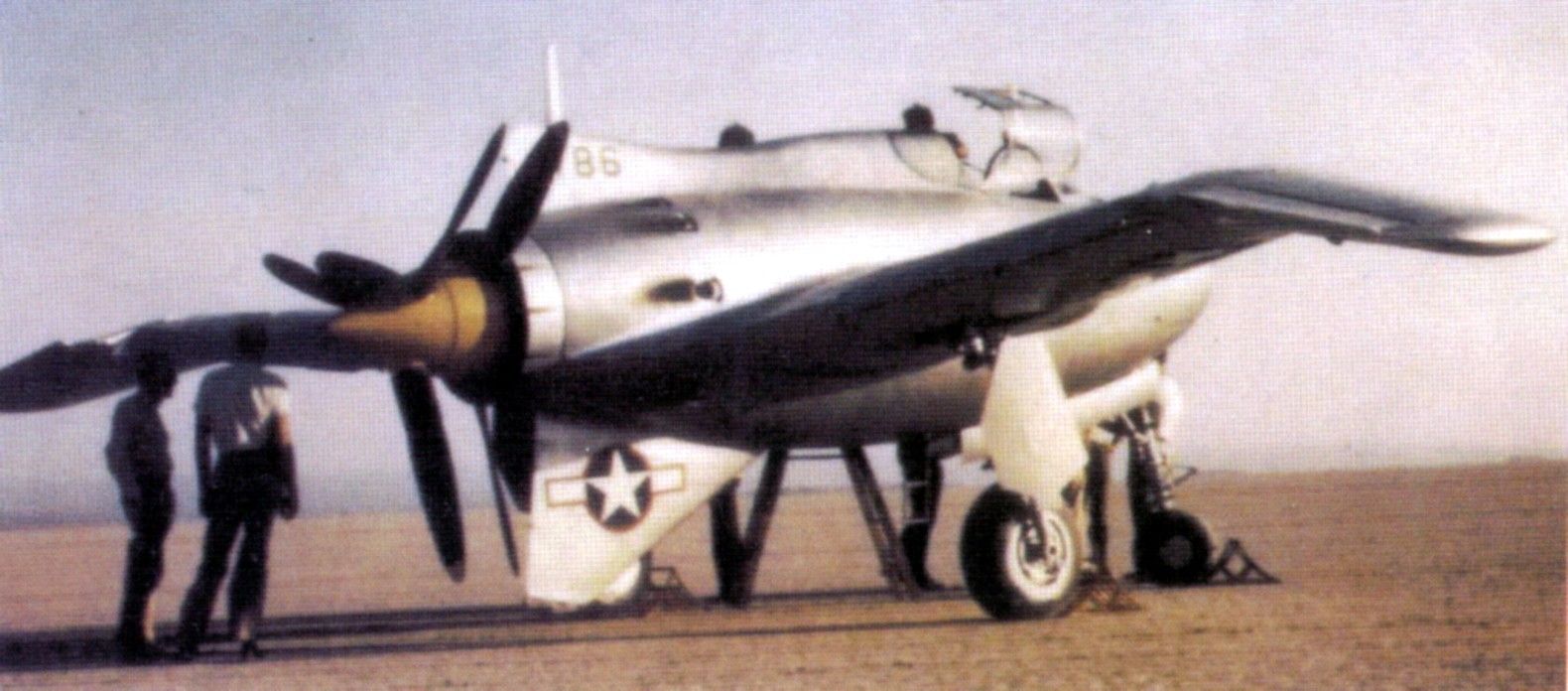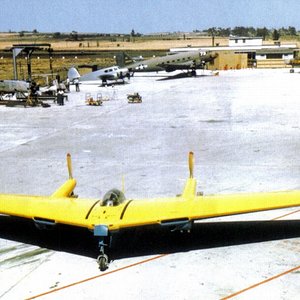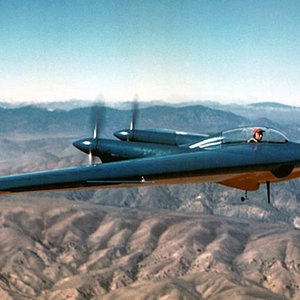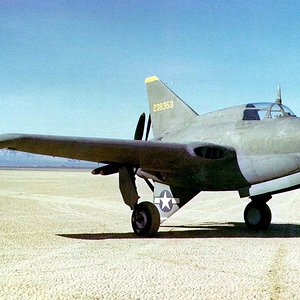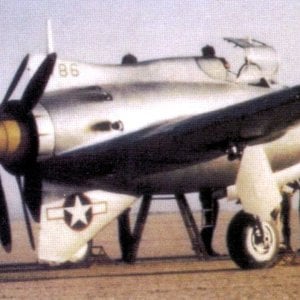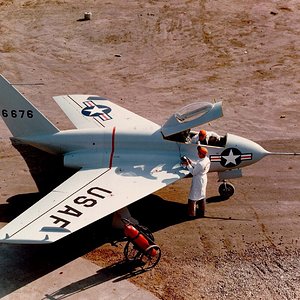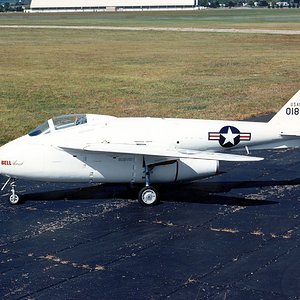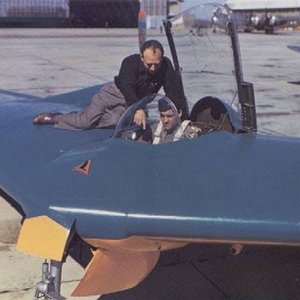Navigation
Install the app
How to install the app on iOS
Follow along with the video below to see how to install our site as a web app on your home screen.
Note: This feature may not be available in some browsers.
More options
You are using an out of date browser. It may not display this or other websites correctly.
You should upgrade or use an alternative browser.
You should upgrade or use an alternative browser.
Design and development
The initial idea for the XP-56 was quite radical for 1939. It was to have no horizontal tail, only a small vertical tail, used an experimental engine, and be produced using a novel metal. The aircraft was to be a wing with a small central fuselage added to house the engine and pilot. The hope was that this configuration would have less aerodynamic drag than a conventional airplane.
The idea for this single-seat aircraft originated in 1939 as the Northrop N2B model. It was designed around the Pratt & Whitney liquid-cooled X-1800 engine in a pusher configuration driving contra-rotating propellers. The U.S. Army ordered Northrop to begin design work on 22 June 1940, and after reviewing the design ordered a prototype aircraft on 26 September 1940. Shortly after design work had begun, Pratt & Whitney, however, stopped development of the X-1800. The Pratt & Whitney R-2800 engine was substituted, although it was considered not entirely suitable. Although the new engine was more powerful (2,000 hp vs 1,800 hp) it had a larger diameter and required a larger fuselage to house it. This change delayed the program by five months. It was expected that the new engine would require a 2,000 lb weight increase and cost 14 mph in top speed.[1] Since this tailless design was novel and considered high risk, it was decided to construct a small, lightweight plane of similar configuration for testing called the Model N-1M. In parallel with the design of the XP-56, successful flight trials of the configuration were conducted utilizing this airframe, confirming the basic layout. Two small Lycoming engines powered this aircraft. These trials confirmed the stability of the radical design and, upon review, the Army decided to construct a second prototype, which was ordered on 13 February 1942.[1]
Northrop constructed the XP-56 using magnesium alloy for the airframe and skin, because aluminium was forecast to be in short supply due to wartime demands. At the time there was little experience with magnesium aircraft construction. Because magnesium cannot be easily welded using conventional techniques, Northrop hired Vladimir Pavlecka to develop the heliarc welding technique for magnesium alloy. (Later it was discovered that in the 1920s General Electric had already developed similar techniques
General characteristics
Crew: one, pilot
Length: 27 ft 6 in (8.38 m)
Wingspan: 42 ft 6 in (12.96 m)
Height: 11 ft 0 in (3.35 m)
Wing area: 306 ft² (28.44 m²)
Empty weight: 8,700 lb (3,955 kg)
Loaded weight: 11,350 lb (5,159 kg)
Max. takeoff weight: 12,145 lb (5,520 kg)
Powerplant: 1 × Pratt & Whitney R-2800-29 radial, 2,000 hp (1,492 kW)
Performance
Maximum speed: 465 mph at 25,000 ft (749 km/h)
Range: 660 miles (1,063 km)
Service ceiling: 33,000 ft (10,061 m)
Rate of climb: 3,125 ft/min at 15,000 ft (953 m/min)
Wing loading: 37 lb/ft² (181 kg/m²)
Power/mass: 0.18 hp/lb (0.96 kW/kg)
Armament
2 × 20 mm (.79 in) cannons
4 × .50 in (12.7 mm) machine guns
The initial idea for the XP-56 was quite radical for 1939. It was to have no horizontal tail, only a small vertical tail, used an experimental engine, and be produced using a novel metal. The aircraft was to be a wing with a small central fuselage added to house the engine and pilot. The hope was that this configuration would have less aerodynamic drag than a conventional airplane.
The idea for this single-seat aircraft originated in 1939 as the Northrop N2B model. It was designed around the Pratt & Whitney liquid-cooled X-1800 engine in a pusher configuration driving contra-rotating propellers. The U.S. Army ordered Northrop to begin design work on 22 June 1940, and after reviewing the design ordered a prototype aircraft on 26 September 1940. Shortly after design work had begun, Pratt & Whitney, however, stopped development of the X-1800. The Pratt & Whitney R-2800 engine was substituted, although it was considered not entirely suitable. Although the new engine was more powerful (2,000 hp vs 1,800 hp) it had a larger diameter and required a larger fuselage to house it. This change delayed the program by five months. It was expected that the new engine would require a 2,000 lb weight increase and cost 14 mph in top speed.[1] Since this tailless design was novel and considered high risk, it was decided to construct a small, lightweight plane of similar configuration for testing called the Model N-1M. In parallel with the design of the XP-56, successful flight trials of the configuration were conducted utilizing this airframe, confirming the basic layout. Two small Lycoming engines powered this aircraft. These trials confirmed the stability of the radical design and, upon review, the Army decided to construct a second prototype, which was ordered on 13 February 1942.[1]
Northrop constructed the XP-56 using magnesium alloy for the airframe and skin, because aluminium was forecast to be in short supply due to wartime demands. At the time there was little experience with magnesium aircraft construction. Because magnesium cannot be easily welded using conventional techniques, Northrop hired Vladimir Pavlecka to develop the heliarc welding technique for magnesium alloy. (Later it was discovered that in the 1920s General Electric had already developed similar techniques
General characteristics
Crew: one, pilot
Length: 27 ft 6 in (8.38 m)
Wingspan: 42 ft 6 in (12.96 m)
Height: 11 ft 0 in (3.35 m)
Wing area: 306 ft² (28.44 m²)
Empty weight: 8,700 lb (3,955 kg)
Loaded weight: 11,350 lb (5,159 kg)
Max. takeoff weight: 12,145 lb (5,520 kg)
Powerplant: 1 × Pratt & Whitney R-2800-29 radial, 2,000 hp (1,492 kW)
Performance
Maximum speed: 465 mph at 25,000 ft (749 km/h)
Range: 660 miles (1,063 km)
Service ceiling: 33,000 ft (10,061 m)
Rate of climb: 3,125 ft/min at 15,000 ft (953 m/min)
Wing loading: 37 lb/ft² (181 kg/m²)
Power/mass: 0.18 hp/lb (0.96 kW/kg)
Armament
2 × 20 mm (.79 in) cannons
4 × .50 in (12.7 mm) machine guns

